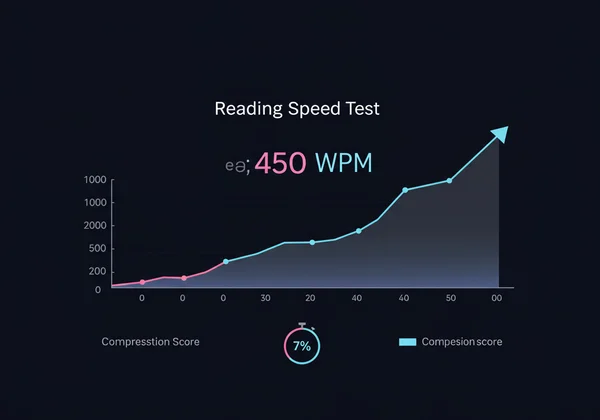告别默读,提升阅读速度:掌握速读技巧
您是否曾在阅读时,“听到”脑海中的字词?这种习惯被称为 默读,看似无害,但却是提高 阅读速度 的主要障碍。如果您曾想过,“如何停止阅读时的默读?”,那么您来对地方了。本文将揭示内在声音拖慢阅读速度的原因,并提供科学依据的策略,助您释放真正的阅读潜能。准备好改变您的阅读习惯了吗?测试您的阅读速度,看看能提高多少!
什么是默读,它为何重要?
默读是指在阅读时,在脑海中默默地“发出”词语的声音。本质上,这是用 内在声音 进行阅读,模仿大声朗读时的体验。对许多人来说,这种习惯源于童年时期,那时我们通过大声朗读来学习阅读。虽然它最初有助于理解,但它将您的阅读速度限制在了说话速度,而这远低于您大脑处理信息的能力。
识别迹象:您默读吗?
要判断您是否 默读 很容易。阅读这句话时,您脑海中有声音吗?如果有,您就在默读。其他迹象包括喉咙或嘴唇的轻微动作,即使没有发出声音。这种 阅读习惯 对大多数人来说根深蒂固,但通过持续的努力是可以克服的。了解这一点对于任何希望提高 阅读效率 的人来说都至关重要。
关于您的内在声音和阅读速度背后的科学
我们的大脑处理信息的速度远超我们嘴巴说话的速度。平均说话速度约为每分钟 120-160 字 (WPM)。如果您默读,您的 阅读速度 基本上就限制在这个范围内。专业速读者的阅读速度通常为每分钟 400-700 字,甚至更高。您的说话速度和大脑的处理速度之间的差距,凸显了依赖内在声音时所损失的潜能。通过减少 默读,您可以释放认知资源以视觉方式处理信息,从而在不牺牲理解的情况下实现更快的阅读。这是掌握有效 速读技巧 的关键一环。

消除内在声音的有效策略
改掉 默读 的习惯需要刻意的练习和耐心。以下是一些直接针对内在声音的有效策略,可帮助您实现真正的 静读。
“嚼口香糖”或哼唱技巧
一种直接扰乱您内在声音的方法是分散声带的注意力,使其难以形成词语。尝试在阅读时嚼口香糖、哼唱曲调,甚至轻声数数“一、二、三、四……”。这项技巧会调动您大脑和口腔中通常参与默读的部分,干扰内在声音的形成。这是您开始提高 阅读流畅度 之旅的简单而强大的 速读技巧。
眼球追踪:指针法和视觉引导
您的眼睛不是在页面上平滑移动;它们会进行快速跳跃(扫视)和短暂的停顿(注视)。默读通常发生在这些注视期间。使用物理或心理 视觉引导 可以帮助您的眼睛更富有节奏地移动,并防止它们在单个词语上停留过久。指针法,即使用手指、笔或虚拟光标平滑地引导您的眼睛阅读,迫使它们保持一致的速度,不给内在声音留下“跟上”的间隙。这可以显著提高您的 阅读速度。

扩大视觉范围:周边视觉训练
大多数读者一次只专注于一个词。然而,我们的 周边视觉 使我们能够同时感知多个词语。通过训练自己将词语视作“词组”或“单元”来阅读,而非逐字阅读,可以减少发出每个词语的需要。练习将目光聚焦在三个词语短语的中心,并尝试一次性吸收这三个词语。逐渐增加每次注视时尝试吸收的词语数量。这种 周边视觉训练 对于提高整体 阅读效率 和实现更高的 WPM 率至关重要。
速读练习和渐进加速
有意识地强迫自己以比平常更快的速度阅读。这并非指仓促行事,而是要强迫您的大脑以加速的速率处理信息,为 默读 留下的空间更少。设定一分钟计时器,尝试尽可能多地阅读,然后对您所阅读的内容进行 阅读理解测试。在每次练习中逐渐提高您的速度。定期使用 阅读速度计算器 可以帮助您跟踪进度,并鼓励更快的眼球运动,从而强化 静读 的习惯。
将静读融入您的日常练习
掌握 静读 并非一蹴而就。它需要持续的练习和战略性的方法,将这些新的 阅读技巧 融入您的日常生活。
克服最初的抗拒和挫败感
您可能会感到沮丧。当您尝试抑制内在声音时,感觉理解力下降是正常的。这是暂时的,因为您的大脑正在适应新的信息处理方式。坚持下去!从简单的文本开始,然后逐渐过渡到更复杂的材料。请记住,目标是实现阅读的平衡:既快又理解透彻。耐心是使这种新的 阅读习惯 得以坚持的关键。
通过阅读速度测试跟踪您的进度
了解您努力成果的最佳方式是衡量您的进步。在练习这些技巧一两周后,进行一次 阅读速度测试。像 我们全面的阅读速度测试 这样的工具可以为您提供准确的 WPM 测试 分数并评估您的 阅读理解能力。这种双重评估至关重要,它能检验您提高的速度是否属于有效的阅读,而非单纯的跳读或略读。当您看到 WPM 提高且理解力保持稳健时,这将是巨大的动力来源。立即通过免费测试发现您的阅读潜力。

释放您的全部阅读潜力:立即行动
消除内在声音是成为真正高效读者的关键。这些 速读技巧 ——从通过哼唱来干扰默读,到扩展视觉跨度和练习速读练习——为您提供了所需的实用工具。无论您是雄心勃勃的学生、不堪重负的专业人士,还是勤奋的终身学习者,请坚持运用这些策略。不要仅仅读得更快,还要读得更聪明,并释放您的全部 阅读潜力。准备好检验您的新技能并看到您的进步了吗?前往 我们的网站进行免费、全面的阅读速度测试,开启您的阅读精进之旅!
关于默读和静读的常见问题解答
停止默读需要多长时间?
显著减少或消除 默读 所需的时间因人而异。通过持续的日常练习(每天 15-30 分钟),许多用户会在几周到几个月内注意到差异。完全掌握 静读 可能需要更长时间,但益处几乎立竿见影。
静读能提高理解力吗?
是的,静读 绝对可以提高理解力,尤其是在长期来看。虽然最初抑制默读的尝试可能会让您觉得理解力下降,但一旦您的大脑适应了以更快的速度进行视觉信息处理,它就会释放认知资源。这使得您可以更好地关注含义和上下文,从而实现更深入的理解和提高 阅读理解能力。
掌握静读后,通常能达到怎样的平均阅读速度?
虽然没有单一的“平均值”,但一个不默读的读者通常可以以良好的理解力达到每分钟 400-700 字的 阅读速度。作为参考,习惯默读的成年人,其 平均阅读速度 通常在每分钟 200-250 字左右。掌握 静读 可以大大提高您的 WPM 测试 分数。您可以通过免费阅读速度测试来评估您当前的阅读速度并跟踪您的进度。
默读总是坏事吗?
不,默读 并非总是“坏事”。对于复杂或专业性强的材料,或者在尝试记忆信息时,轻微的默读可以帮助理解和记忆。它还能让您“听见”作者的声音,从而提升对文学作品的鉴赏力。关键在于控制它,有策略地使用它,而不是让它成为您 阅读效率 的持续障碍。对于一般的阅读,尤其是大量的文本阅读,减少默读对提高阅读速度是有益的。